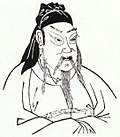Fuji (Chinese: 扶乩 or 扶箕) is a Chinese automatic writing method that uses a suspended sieve or tray called a planchette to guide a stick writing Chinese...
8 KB (781 words) - 16:15, 21 October 2024
compounds tong 童 "child; youth; boy servant" and ji 乩 "to divine" (cf. fuji 扶乩 "divination; planchette writing"). Regional variants include Hokkien tâng-ki...
4 KB (343 words) - 21:44, 10 October 2024
claimed to receive texts from Jìgōng through spirit writing, later called Fuji (扶乩/扶箕 fújī). These messages led to a further development of Jìgōng worship, which...
15 KB (1,623 words) - 07:52, 23 October 2024
from Wong Tai Sin instructing him to construct a new shrine through "Fu Ji" (扶乩), a divination technique that uses a suspended sieve or tray to guide a stick...
13 KB (1,690 words) - 06:29, 25 August 2024
century on, Lüzu's messages were received through Fuji (planchette writing) (扶乩/扶箕), which led to the establishment of a network of Lüzu spirit writing halls...
23 KB (3,075 words) - 06:01, 7 November 2024
by mediums through spirit writing, later called Fuji (planchette writing) (扶乩/扶箕), since the late 17th century. "By the mid-Qianlong period (1736–96) the...
79 KB (11,278 words) - 00:30, 9 November 2024
the result of the ideomotor phenomenon. Spirit writing, later called Fuji (扶乩/扶箕), has a long tradition in China, where messages from various deities and...
32 KB (3,455 words) - 10:09, 7 October 2024
Taoism, two volumes, Routledge, 1106–1107. Despeux, Catherine (2008), "Fuji 扶乩 planchette writing; spirit writing," in The Encyclopedia of Taoism, ed. Fabrizio...
35 KB (3,937 words) - 01:19, 21 June 2024








